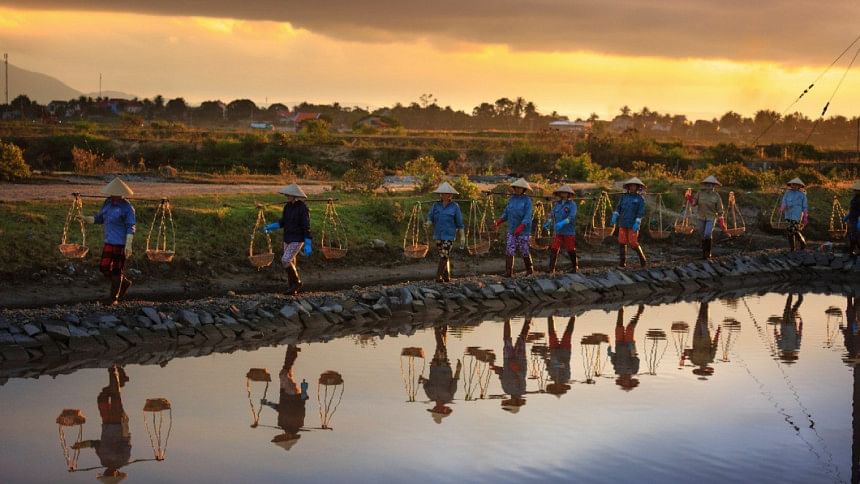Confronting Asia’s triple threat: climate change, biodiversity loss, food insecurity

Emerging from the Covid-19 pandemic, it's clear how ill-prepared the world was for such a crisis. We can see how our inability to deal with decades-old existential threats – notably the degradation of ecosystems, climate change, and food insecurity – has exposed us to pandemics, disasters triggered by natural hazards, and now worsening hunger.
Today, the food crisis is the most immediate threat for many countries. Even before the Russian invasion of Ukraine disrupted supplies of food staples and fertiliser, progress towards the Sustainable Development Goal of eradicating global hunger had reversed. Asia and the Pacific have the highest number of people facing acute food insecurity worldwide – three times higher than before COVID-19 and due largely to fallout from the pandemic, climate-related events, and macroeconomic stresses.
This year, food inflation has spiked to all-time highs for oil, cereals, and meat prices, and the cost of sugar and dairy products has soared. The FAO food price index, a global standard for measuring food prices, hit a record high in March 2022, and though it has since retreated it remains 7.9 per cent above its value a year ago.
There is no easy solution, but there is a clear path. A meaningful response must recognise the triple threat facing Asia—climate change, biodiversity loss, and food insecurity. These challenges are deeply interlinked, and the current food security crisis will get even worse if we fail to address them.
Floods, droughts, disease, and other climate impacts will curtail food production. The recent flooding in Pakistan reinforces this reality. Disruptions to livelihoods will drive even more food scarcity, compounded by climate-induced migration.
It's also important to acknowledge the impacts of agriculture on climate and natural ecosystems. Agriculture uses 70 per cent of the world's water resources, 50 per cent of habitable land, and causes up to 80 per cent of biodiversity loss. Emissions of methane and nitrous oxide from agriculture contribute significantly to global warming.
Addressing climate change and biodiversity must not be an afterthought in efforts to end this food crisis. Rather, it should be central to a comprehensive transformation of global food systems.
The first step is to overhaul the food supply chain infrastructure to make it climate resilient. This means building infrastructure such as cold storage, warehouses, rural connectivity, and digital services that are accessible and affordable for farmers. The recent Pakistan floods showed the importance of building climate-resilient food storage such as silos.
Technologies such as early warning systems for extreme climate-related events, or online weather advisory and forecasting services, can help farmers manage their crops better. Better rural connectivity can support logistics of agriculture supplies, while technologies such as remote sensing can improve land-use planning and management through monitoring and diagnostics
Second, we must ensure that food production is climate-smart through approaches like integrating natural resources management into efforts to reduce greenhouse gas emissions. Balancing productivity against climate change adaptation and mitigation outcomes demands a much broader perspective covering the entire food supply chain from production to processing, packaging, transportation and, finally, to the consumer.
Third, we must deploy nature-based solutions to support agricultural production while helping to regenerate ecosystems. Nature-based solutions involve conserving or rehabilitating natural ecosystems and the enhancement or creation of natural processes in modified or artificial ecosystems.
These solutions might include community-based agroforestry, which enhances soils and protects biodiversity while improving crop resilience and rural livelihoods. Integrating native flora into cattle pastures, reducing soil tillage intensity, and restoring habitats crucial to watershed health, are other good examples of nature-based solutions.
Delivering these and other solutions demands transformative change and innovation at every point along the food system. It will also involve behavioural changes in our consumption patterns. The role of the private sector will be critical, through smart investments in agriculture that deliver development impact as well as profit.
At an individual level, consumers can help by changing their dietary habits toward nutritious plant-based foods that produce fewer emissions than animal-based food production. Animal-based foods constitute nearly 57 per cent of global greenhouse gas emissions from food production, and a shift to plant-based foods can lead to a significant reduction in these emissions.
Development organisations also have an important role.
Without progress on climate and biodiversity, there will be no progress on food. The scale of this triple threat demands an unprecedented level of multilateral, private, and public sector cooperation.
We need to act now before the impacts of climate change worsen, leaving more families vulnerable and hungry, and eroding the region's hard-won prosperity.
Bruno Carrasco is the chief compliance officer of the Sustainable Development and Climate Change Department at the Asian Development Bank and Qingfeng Zhang is the chief of the Rural Development and Food Security Thematic Group.

 For all latest news, follow The Daily Star's Google News channel.
For all latest news, follow The Daily Star's Google News channel. 








Comments